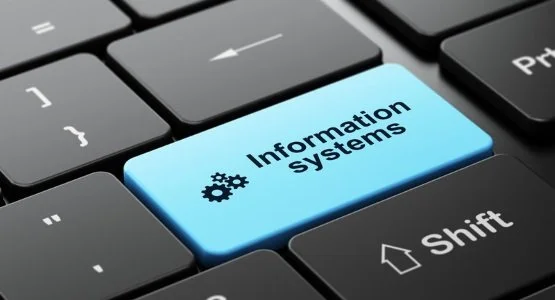Information Systems
Subject: Business
Objective: By the end of the lesson students should understand the fundamental foundations of Information Systems as one of the functions of a business. They will explore both how the management of data and communications throughout an organization, and its supply chain through to its consumers/market, can be a critical consideration in determining an organization’s success.
An overview on Information Systems created by 5-Minute Videos by Victor.
What are Information Systems?
Key Terms
DATA - A raw representation of facts, words, observations or descriptions.
INFORMATION - A logical application of data in a meaningful context.
Through the course so far we’ve explored different functions of a business, how they enable not only an organization to conduct its day-to-day business, but to thrive. Each one we’ve touched upon has had not only a specific purpose, but also options for differentiation strategies - ways to set your business apart from your market competition. After all, as we explored in our Blockbuster assignment, if an organization is not knowing and growing, it’s dying. So then, what is Information Systems, and how does it tie in?
Information systems is defined by Clute Journals as a system which:
collects, processes, stores, analyzes and disseminates information for specific purposes.
Clear as mud? Basically, it is a system which takes data, refines it to be relevant to a specific context and application, makes it comparable and communicable - so it’s useful to those who need it, distributes it to the people who need it, and effectively stores/secures the information.
A video on the difference between data and information created by Intricity 101
What forms can that take?
While you might expect it from that definition to be something like an integrated software, information systems are actually far broader in scope than that. It generally takes the form of a comprehensive marriage of hardware, software, and telecommunications networks to not only manage the ins-and-outs of the organization’s business, but also to interact with its customers. As Emeritus points out, “some companies are entirely built on information technologies, like like eBay, Amazon, Alibaba, and Google.” These organizations house data beyond comprehension, and naturally that type of data would grind meaningful operations to a halt without a structured system to ensure it is meaningfully filtered and processed into information.
“Technology makes it possible to align buyers and suppliers with accurate, real-time data... Working on outdated data is no recipe for success. Consider your options to help you beat the competition and deliver to your customers.”
So what would that mean in practice? That would mean that an organization of significant scale, operating in a domain where the volume of data is particularly excessive, would need not only an effective software, but the infrastructure in the form of hardware (networks, servers, etc.), and governance by way of formal rules and staffing to support it. Those staff would take the form of network architects, system administrators, analysts (security and systems), as well as (obviously) computer support specialists - for when you’re having some trouble as you inevitably will.
Next let’s take a look at one of the most well-known forms of information systems in the world since the 1990’s, Enterprise Resource Planning (ERP).
Image credit CX Today - Source: https://www.cxtoday.com/data-analytics/what-are-the-primary-business-benefits-of-an-erp-system/
FOCUS: ENTERPRISE RESOURCE PLANNING
A brief summary of the nature of ERP software as created by NetSuite.
Interesting points to consider
Not only does an effective ERP support your organization in both data accuracy and cost/time savings, here are a few stats in support of an appropriate ERP approach:
Streamlined use of ERP platforms allow for seamless real-time access to data
These approaches not only support single organizations, but can enable both vertical and horizontal supply chain collaboration
The use of AI enables employees to significantly decrease the amount of time they spend sifting through data for relevant information or making direct contact with clients/customers
While it evolved from manufacturing approaches and tools in the 1970’s and 1980’s, the Enterprise Resource Planning (ERP) system is an example of an IS tool which has been in use since the early 1990’s when it was conceptually developed and applied by Gartner (then “The Gartner Group”). Its primary purpose is to effectively share information across all sections of a business. When we discussed supply chain management and operations management previously, we covered the dynamics involved in decisions like a price point analysis - that the cost of a product reflected far more than just the sum of its materials, assembly, and profit margins. We explored the procurement, transportation and handling costs, overhead costs of storage, insurance along the supply chain, etc., with a focus on the finances and logistics involved. Here we now we’ll consider the data (not that it wasn’t involved before), as we can surely understand that not every person on a forklift at each loading dock along the supply chain needs to know every piece of data surrounding the development of your product. To that end, it takes a keen eye to sift through all of the data involved and process it into useful information to be delivered to the right people, at the right time, for the right costs, through the right channels.
Image source credit Indeed.com: https://www.indeed.com/career-advice/career-development/what-is-erp
ERP was developed for precisely that reason, to incorporate and manage the data of elements such as project management, supply chain management, manufacturing, finance, human resources and customer relationship management, processing them, packaging them, securely transmitting them, and so on, in a timely manner between the different departments and along the chain. Further, since the 90’s it has evolved to incorporate modern domains such as ecommerce, web dashboards, and cloud-based multi-tier subsidiary systems.
Cloud-based ERP software has become particularly enabling in today’s work environments. Certainly one would see how it would benefit an organization which is transnational or multinational, but in recent years we’ve seen an explosion in demand as a result of a push for things like remote work. Much like in our Organizational Structure lesson we discussed a matrix approach to overcoming a challenge, when the COVID pandemic hit, cloud-based ERP was an enabler for overcoming the challenge of continuing to function in many drastically impacted industries.
Assignment
Here we’ve explored an introduction to key terms and concepts, and we’ve explored one of the most prominent reflections of information systems approaches, ERP. However, ERP systems can be expensive as licensing fees are often quite high, they require (ideally) third-party support for optimal integration, they tend to be inflexible, and it can take time to sort the bugs out - particularly for well established organizations with larger pools of employees accustomed to a specific workflow. Consider having your students explore the alternatives, present the pros and cons and contexts where one approach would work better than its alternatives. Recommendations for research would include Customer Relationship Management (CRM), Manufacturing Execution System (MES), and modern accounting software alternatives.



